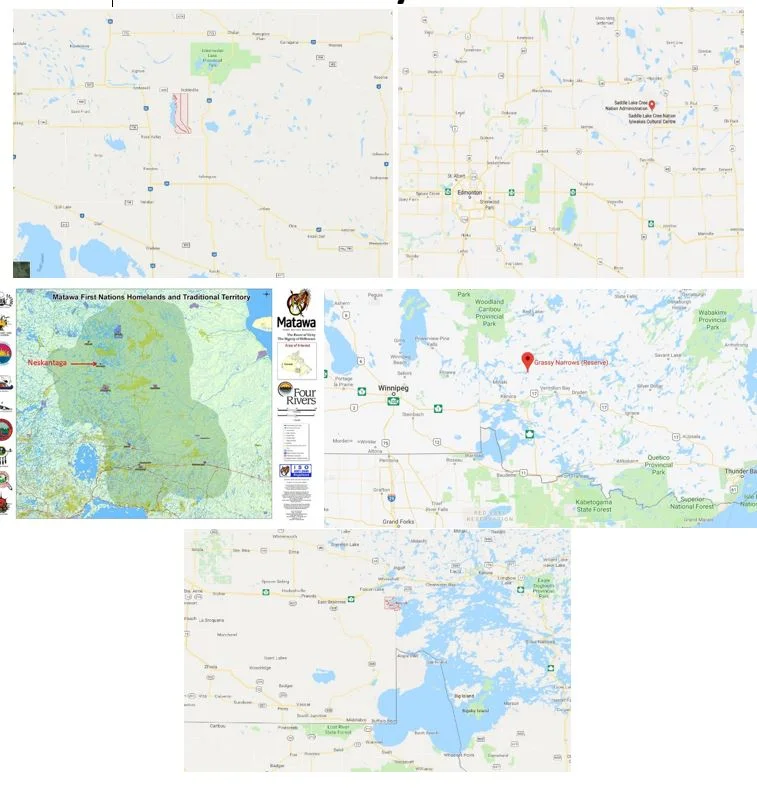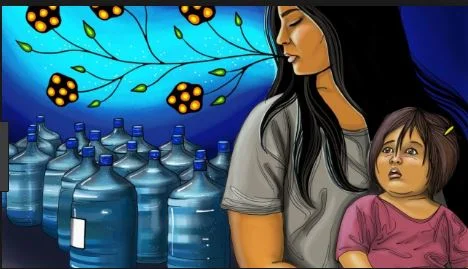Curriculum Connections for Operation Water Spirit - All provinces and territories, all grade levels, many subject areas. The Table of Contents is clickable, so you can find what you need.
Grades 10-12 Lesson 1: Water in First Nations Ceremonies
“Water has to live, it can hear, it can sense what we’re saying, it can really, really speak to us. Some songs come to us through the water. We have to understand that water is very precious.” – Josephine Mandamin, Water Walker, 1942-2019
Water is one of the four elements that are very sacred to First Nations people. Many First Nations ceremonies involve water. These ceremonies include water walks, water ceremonies, sweat lodges, and fasts. These ceremonies will be described, videos about them will be watched, and a special type of discussion will be held.
Grades 10-12 Lesson 2: The Tale of Yellow Quill
“Yellow Quill is a community some two and a half hours northeast of Saskatoon and I fear for the health of its community members because the tap water is so bad.” – Carla Plotnikoff, Environmental Health Officer for Saskatoon Tribal Council
Yellow Quill First Nation was under a boil water advisory for nine years. Yellow Quill’s water was thought to be untreatable. However, a scientist named Dr. Hans Peterson conducted a 22-month pilot and research project in Yellow Quill, which led to the development of the Integrated Biological and Reverse Osmosis Membrane (IBROM) treatment process.
Grades 10-12 Lesson 3: The Tale of Grassy Narrows
“It’s been a devastation of a whole way of life, a whole… culture that we need to rebuild.” – Judy Da Silva, Environmental Health Coordinator for Grassy Narrows
Grassy Narrows is a remote Northwestern Ontario reserve with approximately 1000 residents. Its water supply has been contaminated by mercury for over 50 years. Due to inadequate treatment of surface water and uranium-contaminated well water, there are currently four boil water advisories at Grassy Narrows. The contamination has already had a long-term public health impact on-reserve.
Grades 6-9 Lesson 1: Medicine Wheel
“Water finds significance in the lives of First Nations people on personal, community, clan, national, and spiritual levels. Water is understood as a living force which must be protected and nurtured; it is not a commodity to be bought and sold.” - Unknown
All around Turtle Island (North America), the Medicine Wheel has been used as a teaching tool for many Indigenous Nations. Medicine Wheels consist of many different aspects that connect humans and all living things to the Earth.
Grades 3-5 Lesson 1: Respecting Our Water
“In order to respect the water we have to respect the land. The land is a natural filtration system for our water. We don’t take care of the land, the water becomes sick.” - Unknown
Students will be exposed to the protocol for approaching an Elder while learning the importance of respecting the water and land.
Grades 10-12 Lesson 4: The Tale of Shoal Lake 40
“It’s on the Manitoba-Ontario border, there are two First Nations involved, [the community] is not isolated, just south of the Trans-Canada Highway, it’s complex just getting there geographically, and incredibly complex getting there politically.” – Cuyler Cotton, Co-ordinator for both the Water Servicing and All Weather Road Projects
A century ago, the federal government expropriated land inhabited by the Shoal Lake 40 First Nation for construction of an aqueduct to provide water to the city of Winnipeg. Band members were moved onto a man-made island. Shoal Lake 40 has been under a boil water advisory since February 18, 1997.
Grades 6-9 Lesson 2: What Is Water?
“I think water is probably an issue where we (Aboriginal community and scientific community) can find common ground for discussion…it is something we all can stand behind.” – Dr. Alexander Zehnder, Scientific Director – Water Resources – Alberta Innovates
Water is a molecule composed of two hydrogen atoms and one oxygen atom. Water can be in three states: solid, liquid and gas. Many contaminants are often found in water
Grades 3-5 Lesson 2: Ceremonial Uses for Water
Grades 6-9 Lesson 3: Five Community Water Tales
“Tainted water and broken systems on Ontario’s First Nations reserves are jeopardizing health, burdening parents and caregivers, and exacerbating problems on reserves. First Nations people have the same human rights to adequate water and sanitation as all Canadians, but in practice cannot access them.” – Amanda Klasing, Senior Researcher, Women’s Rights Division, Human Rights Watch
Grades 10-12 Lesson 5: The Tale of Saddle Lake Cree Nation
“I’ve never seen a water supply in such poor shape! The lake is covered with blue greens, which make mats in nearshore areas. Yet this is a drinking water supply for several thousand First Nations people! This is a story that city people need to hear and see. They cannot imagine that we have water problems of this magnitude in Alberta.” – Dr. David Schindler
The community draws its water from Saddle Lake, which has 25-30 ppm of organics, as well as large algal blooms in the summer.
Grades 3-5 Lesson 3: Hydropower/Hydro Activity: Is it Bad or Good?
“Our land is more valuable than your money. It will last forever. It will not even perish by the flames of fire. As long as the sun shines and the waters flow, this land will be here to give life to men and animals.” - Chief Crowfoot, Siksika (1825-1890)
This lesson will focus on the effects hydropower/hydro activity has on Indigenous communities across Canada.
Grades 6-9 Lesson 4: Current First Nations Water Issues
“I think once we understand each other a bit more clearly, we can tell the rest of the people, this is what’s happening to our water and how to take care of it – because it’s taken care of us up till now.” – Violet Poitras, Nakota/Cree Elder, Paul First Nation
In 2015, Justin Trudeau campaigned on a promise to end all long-term drinking water advisories by March 2021.
Grades 10-12 Lesson 6: The Tale of Neskantaga
“For more than 20 years we haven’t been able to drink water from our taps or bathe without getting rashes. Water is a basic human right, and it should not have taken this long to provide the people of Neskantaga with access to safe drinking water.” – Neskantaga Chief Wayne Moonias
Neskantaga First Nation in Northern Ontario has the longest-standing drinking water advisory of any First Nation in Canada. Two decades ago, their water-treatment plant (which was then only a couple of years old) broke down – never to run again, and this means that the water could be contaminated with any number of bugs that pose threats to human health. This affects the daily lives of the over 340 residents of this First Nation.
Grades 3-5 Lesson 4: Water Is Important
“No child should grow up not knowing what clean water is, or never knowing what running water is.” – Autumn Peltier
The percentage of the human body that is water ranges from 50% to 75%. The average adult is 50% to 65% water. Infants are approximately 75% water. The percentage of the human body that is water declines with age. We need to replenish our body with safe drinking water. Sometimes there are contaminants in the water and that causes a Boil Water Advisory to be called. Sometimes the contaminants cannot be removed through boiling and, therefore, a Do Not Use Advisory is issued instead. Neskantaga First Nation in Ontario has been under a Boil Water Advisory for over 23 years!
Grades 6-9 Lesson 5: Traditional Knowledge and Traditional Ecological Knowledge
Traditional knowledge is often referred to as Indigenous knowledge and local knowledge. It is knowledge that is handed down through generations about life experiences. Traditional knowledge includes knowledge about the land, the people, the creator, and other things like traditional practices such as ceremonies, religious practices such as prayer, and teachings about life.
K-2 Lesson 1: Medicine Wheel
K-2 Lesson 2: Respecting Water
“As Indigenous Peoples, we recognize, honour and respect Water as a sacred and powerful gift from the Creator. Water, the first living spirit on this earth, gives life to all creation. Water, powerful and pristine, is the lifeblood that sustains life for all peoples, lands and creation. We know that by listening to the songs of the Water, all creation will continue to breathe. Our knowledge, laws and ways of life teach us to be responsible at all times in caring for this sacred gift that connects all life.” - Musqueam Territory Elder
K-2 Lesson 3: Ceremonial Uses of Water
“Water is what sustains us. Water is what brings us into this world, and water is what keeps us in this physical world. And so it’s our life.” - Jan Longboat
To help students understand how and why water was and is used in First Nations ceremonies. Specific ceremonies that will be looked at are the women’s water ceremony, fasting, sweat lodge, and giving thanks.
K-2 Lesson 4: Hydropower - Is it Bad or Good?
"We wouldn't be able to live without water. Nothing would." – Autumn Peltier
Energy, we all use it every day. We often hear that renewable sources of energy are better than non-renewable sources of energy. However, renewable sources of energy also have effects on the environment.
In this lesson, students will learn about hydropower and see the growth of their knowledge. They will also form an opinion on whether hydropower is bad or good.




















